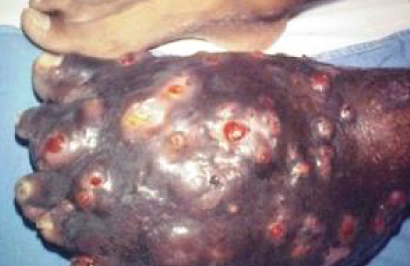
Study brings hope to combat eumycetoma, one of the most neglected diseases in the world
The work is being developed with a budget under US$2 million; similar studies held by large pharmaceutical companies cost over US$160 million
11/01/2016
The disease has few treatment alternatives and the patients rely on rare options besides the amputation of the affected members
Eumycetoma, a chronic cutaneous or subcutaneous infection caused by fungi from the Eumycetes genus, is one of the most chronic problems in poor countries. There are not even official numbers about the disease, which has only been on the World Health Organizations (WHO) neglected disease list for two years. The disease affects mainly males living in rural areas. Relying on rare treatment alternatives, the patients usually have few options besides the amputation of the affected members. However, hope for the problem may be finally close.
A work developed by the Drugs For Neglected Diseases Initiative will study for the next two years a new drug against the infection, which can affect any part of the body, mainly the feet. This new drug is fosravuconazole, a medication with antifungal properties developed by Eisai, a Japanese company.
This double-blind study will enroll 138 people living in Sudan, Africa, diagnosed with early stage mycetoma. The work will compare the effectiveness of fosravuconazole against the standard treatment, which uses the antifungal drug intraconazole – an inneficcient (with cure rates ranging between 25% and 37%), toxic and expensive drug.
The treatment [with itraconazole] is extremely expensive – for some poor Sudanese , it can cost up to half their monthly salary. Patients resort to traditional healers, who use traditional scarring methods and reports exist of painful methods such as using battery acid, explains Ed Zijlstra, DNDis consultant.
The work in Sudan, however, will face a series of obstacles. The main one is the budget under US$ 2 million – large pharmaceutical companies have invested over US$ 160 million developing a new drug, according to DNDi. Other barriers include the lack of local infrastructure, as no well-equipped hospitals and precarious access ways to the patients.
Anyhow, if positive results are achieved, the drug will be available at accessible prices, according to Zijlstra. When designing its R&D (research and development) projects, DNDi puts the patients needs into the heart of each project. Products must be affordable, easy-to-take and usable in tropical, low-resource environments, he said.
Until now there has hardly been any drug development work for drugs against mycetoma. Except for a few researchers in the Netherlands and in Sudan, there has been little research on this disease. We also face very poor data about the burden – testimonials from a village we visited in the Gezira state (an endemic area), in Sudan, showed a prevalence of 4% – considered very high, said Zijlstra.
The development of the work is supported by institutions as the Bill & Melinda Gates Foundation and Doctors Without Borders (MSF). You can also contribute with this and other DNDi initiatives by clicking here.…










